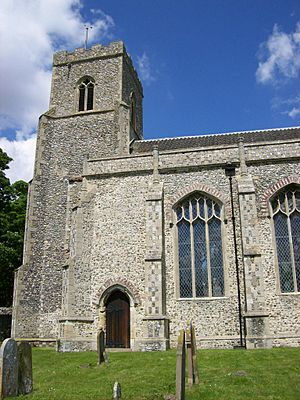St John and St Mary, Stiffkey facts for kids
St John the Baptist and St Mary's Church is a historic church in the village of Stiffkey in Norfolk, England. It is named after John the Baptist and the Virgin Mary. Long ago, there were actually two churches in the same churchyard. One of them, St Mary's, was no longer used after 1563. So, the other church, St John's, was then given both names. The church is also known because of its connection to Harold Davidson, who was a Rector (a type of priest) here for many years.
Contents
What Does the Church Look Like?
The church building mostly shows a style called Perpendicular. This means it has tall, straight lines and big windows. However, the tall tower at the west end and a special room called a charnel are older.
The main part of the church, called the nave, has four sections. It also has a special stone decoration called flushwork along the top edge. The area near the altar, called the chancel, was built in the late 1200s or early 1300s. You can still see the stairs that once led to a rood screen on the south side of the nave.
Inside, there is a wall monument dedicated to Nathaniel Bacon of Stiffkey. This monument was made before 1615, possibly by a famous artist named Maximilian Colt. This church is very important, so it is a Grade I listed building. This means it has special historical protection.
The church also has a war memorial. It is a tablet on the wall that shows a scene called Calvary. A former Rector, Harold Davidson, asked for it to be made.
The organ in the church was built by the Positive Organ Company. Their organs were usually small and easy to move, perfect for smaller churches. We don't know the exact year it was built, but the company worked between 1898 and 1941. The organ was updated in 1954 by Williamson & Hyatt.
How the Church Works with Others
Churches sometimes join together to share resources. This is called "consolidation." In 1769, the church in Stiffkey joined with All Saints Church in Morston. Later, in 1972, it joined with St Andrew and St Mary in Langham Episcopi.
It joined with even more churches in 1976. These included All Saints Cockthorpe (which is no longer used as a church) and Binham Priory. Then, in 2003, it joined with even more churches. These were St Mary in Gunthorpe, All Saints in Bale, St Andrew in Field Dalling, St Margaret in Saxlingham, and All Saints in Sharrington. Now, all these churches work together as the Benefice of Stiffkey (St John and St Mary) and Bale.
Important People Who Worked Here
Many interesting people have served as clergy (like priests or rectors) at this church:
- Theophilus Lowe was the Rector from 1736 to 1769. He also held another important church job at the same time, as a Canon of Windsor.
- George Townshend Hudson was Rector from 1842 to 1845. His uncle was married to the 6th Duke of Leeds. George's brother, Sir James Hudson, was an ambassador for England in Italy.
- Charles Harold Fitch was Rector from 1932 to 1942. He was known for his voice. He spoke about the local Norfolk accent in a series for the British Drama League.
- Victor Thomas South Jagg was Rector from 1946 to 1955. He was a brave soldier and received the Military Cross award in 1919.
- Cecil Howard Dunstan Cullingford was Rector from 1968 to 1971. Before this, he was the Headmaster of Monmouth School. He was also a famous speleologist, which means he studied caves. He wrote several books about exploring caves and caving techniques.
Who is Buried Here?
The churchyard is where people are buried. Some notable people buried here include:
- Aubrey Buxton, Baron Buxton of Alsa (1918-2009) and his first wife, Pamela (1922-1983).
- Harold Davidson (1875-1937), who was the Rector of Stiffkey from 1906 to 1932.
- Eugene Sweny (1837-1906), who was Rector from 1883 to 1906. His grave has a large stone Celtic cross.


